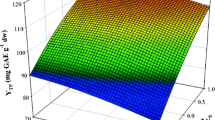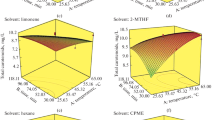Abstract
This investigation was carried out with the scope to examine three commonly used cyclodextrins (CDs), β-cyclodextrin (β-CD), methyl β-cyclodextrin (m-β-CD) and 2-hydroxypropyl β-cyclodextrin (HP-β-CD) as green co-solvents for the effective extraction of polyphenols and pigment from onion solid wastes (OSW). Efficiency appraisal was based on the “extraction efficiency index” (Iee), a parameter established to readily assess the ability of a CD to boost aqueous polyphenol extraction. m-β-CD was found to be the most efficient, giving Iee of 3.39 and 0.073 mg μmolCD−1 for total polyphenols and total pigments, respectively. Response surface optimization revealed that both m-β-CD and HP-β-CD required almost identical time and temperature conditions for maximized polyphenol recovery, but major differences were found for pigment extraction. β-CD was the least efficient in extracting total polyphenols, but it displayed a satisfactory effectiveness in pigment extraction. The antiradical activity and ferric-reducing power of the extracts generated with m-β-CD and HP-β-CD were comparable to those of hydroethanolic and hydroglycerolic extracts. Both these CDs were also more efficient than β-CD in extracting spiraeoside and quercetin, but β-CD exhibited higher efficiency for anthocyanin extraction.








Similar content being viewed by others
References
Lizárraga-Velázquez CE, Leyva-López N, Hernández C, Gutiérrez-Grijalva EP, Salazar-Leyva JA, Osuna-Ruíz I, Martínez-Montaño E, Arrizon J, Guerrero A, Benitez-Hernández A (2020) Antioxidant molecules from plant waste: extraction techniques and biological properties. Processes 8:1566
Ben-Othman S, Jõudu I, Bhat R (2020) Bioactives from agri-food wastes: present insights and future challenges. Molecules 25:510
Burlini I, Sacchetti G (2020) Secondary bioactive metabolites from plant-derived food byproducts through ecopharmacognostic approaches: a bound phenolic case study. Plants 9:1060
Ren F, Nian Y, Perussello CA (2020) Effect of storage, food processing and novel extraction technologies on onions flavonoid content: a review. Food Res Inter. https://doi.org/10.1016/j.foodres.2019.108953
Ly TN, Hazama C, Shimoyamada M, Ando H, Kato K, Yamauchi R (2005) Antioxidative compounds from the outer scales of onion. J Agric Food Chem 53:8183–8189
Ramos FA, Takaishi Y, Shirotori M, Kawaguchi Y, Tsuchiya K, Shibata H, Higuti T, Tadokoro T, Takeuchi M (2006) Antibacterial and antioxidant activities of quercetin oxidation products from yellow onion (Allium cepa) skin. J Agric Food Chem 54:3551–3557
Osman A, Makris DP (2010) Comparison of fisetin and quercetin oxidation with a cell-free extract of onion trimmings and peel, plant waste, containing peroxidase enzyme: a further insight into flavonol degradation mechanism. Inter J Food Sci Technol 45:2265–2271
Moussouni S, Makris DP (2014) Optimisation of onion peroxidase-catalysed formation of aureusidin using 2’, 4’, 6’, 3, 4-pentahydroxy chalcone as substrate. J BioSci Biotech 3(2):141–146
Sharma K, Mahato N, Nile SH, Lee ET, Lee YR (2016) Economical and environmentally-friendly approaches for usage of onion (Allium cepa L.) waste. Food Function 7:3354–3369
Kefalas P, Makris D (2006) Exploitation of agri-food solid wastes for recovery of high added-value compounds: the case of grape pomace and onion peels. Bul USAMV-CN 62:276–281
Makris D, Kefalas P (2015) Kinetic modelling for polyphenol extraction from onion (Allium cepa) solid wastes using acidified water/ethanol mixture. Acta Alim 44:482–492
Viera V, Piovesan N, Rodrigues J, deOMello R, Prestes R, dos Santos R, deAVaucher R, Hautrive T, Kubota E (2017) Extraction of phenolic compounds and evaluation of the antioxidant and antimicrobial capacity of red onion skin. Inter Food Res J 24(9):990–999
Jin EY, Lim S, ohKim S, Park Y-S, Jang JK, Chung M-S, Park H, Shim K-S, Choi YJ (2011) Optimization of various extraction methods for quercetin from onion skin using response surface methodology. Food Sci Biotech 20:1727–1733
Katsampa P, Valsamedou E, Grigorakis S, Makris DP (2015) A green ultrasound-assisted extraction process for the recovery of antioxidant polyphenols and pigments from onion solid wastes using Box-Behnken experimental design and kinetics. Ind Crops Prod 77:535–543
Campone L, Celano R, Piccinelli AL, Pagano I, Carabetta S, Di Sanzo R, Russo M, Ibañez E, Cifuentes A, Rastrelli L (2018) Response surface methodology to optimize supercritical carbon dioxide/co-solvent extraction of brown onion skin by-product as source of nutraceutical compounds. Food Chem 269:495–502
Munir M, Kheirkhah H, Baroutian S, Quek SY, Young BR (2018) Subcritical water extraction of bioactive compounds from waste onion skin. J Clean Prod 183:487–494
Stefou I, Grigorakis S, Loupassaki S, Makris DP (2019) Development of sodium propionate-based deep eutectic solvents for polyphenol extraction from onion solid wastes. Clean Technol Environ Pol 21:1563–1574
Jansook P, Ogawa N, Loftsson T (2018) Cyclodextrins: structure, physicochemical properties and pharmaceutical applications. Inter J Pharm 535:272–284
Chemat F, Abert-Vian M, Fabiano-Tixier AS, Strube J, Uhlenbrock L, Gunjevic V, Cravotto G (2019) Green extraction of natural products. Origins, current status, and future challenges. Trends Anal Chem 118:248–263
Chemat F, Abert Vian M, Fabiano-Tixier AS, Nutrizio M, Režek Jambrak A, Munekata PES, Lorenzo JM, Barba FJ, Binelloe A, Cravotto G (2020) A review of sustainable and intensified techniquesfor extraction of food and natural products. Green Chem 22:2325–2353
Ratnasooriya CC, Rupasinghe HV (2012) Extraction of phenolic compounds from grapes and their pomace using β-cyclodextrin. Food Chem 134:625–631
Rajha HN, Chacar S, Afif C, Vorobiev E, Louka N, Maroun RG (2015) β-Cyclodextrin-assisted extraction of polyphenols from vine shoot cultivars. J Agric Food Chem 63:3387–3393
Lakka A, Lalas S, Makris DP (2020) Development of a low-temperature and high-performance green extraction process for the recovery of polyphenolic phytochemicals from waste potato peels using hydroxypropyl β-cyclodextrin. Appl Sci 10:3611
Lakka A, Lalas S, Makris DP (2020) Hydroxypropyl-β-Cyclodextrin as a green co-solvent in the aqueous extraction of polyphenols from waste orange peels. Beverages 6:50
Grigorakis S, Benchennouf A, Halahlah A, Makris DP (2020) High-performance green extraction of polyphenolic antioxidants from Salvia fruticosa using cyclodextrins: optimization, kinetics, and composition. Appl Sci 10:3447
Saokham P, Muankaew C, Jansook P, Loftsson T (2018) Solubility of cyclodextrins and drug/cyclodextrin complexes. Molecules 23:1161
Karageorgou I, Grigorakis S, Lalas S, Mourtzinos I, Makris DP (2018) Incorporation of 2-hydroxypropyl β-cyclodextrin in a biomolecule-based low-transition temperature mixture (LTTM) boosts efficiency of polyphenol extraction from Moringa oleifera Lam leaves. J Applied Res Med Arom Plants 9:62–69
Lakka A, Karageorgou I, Kaltsa O, Batra G, Bozinou E, Lalas S, Makris D (2019) Polyphenol extraction from Humulus lupulus (hop) using a neoteric glycerol/L-alanine deep eutectic solvent: Optimisation, kinetics and the effect of ultrasound-assisted pretreatment. AgriEngineering 1:403–417
Dourtoglou VG, Mamalos A, Makris DP (2006) Storage of olives (Olea europaea) under CO2 atmosphere: effect on anthocyanins, phenolics, sensory attributes and in vitro antioxidant properties. Food Chem 99:342–349
Makris DP (2010) Optimisation of anthocyanin recovery from onion (Allium cepa) solid wastes using response surface methodology. J Food Technol 8:183–186
Makris DP, Rossiter JT (2001) Comparison of quercetin and a non-orthohydroxy flavonol as antioxidants by competing in vitro oxidation reactions. J Agric Food Chem 49:3370–3377
Kicuntod J, Sangpheak K, Mueller M, Wolschann P, Viernstein H, Yanaka S, Kato K, Chavasiri W, Pongsawasdi P, Kungwan N (2018) Theoretical and experimental studies on inclusion complexes of pinostrobin and β-cyclodextrins. Scient Pharmaceut 86:5
Cai R, Yuan Y, Cui L, Wang Z, Yue T (2018) Cyclodextrin-assisted extraction of phenolic compounds: current research and future prospects. Trends Food Sci Technol 79:19–27
Gonzalez Pereira A, Carpena M, García Oliveira P, Mejuto JC, Prieto MA, Simal Gandara J (2021) Main applications of cyclodextrins in the food industry as the compounds of choice to form host–guest complexes. Inter J Mol Sci 22:1339
Athanasiadis V, Grigorakis S, Lalas S, Makris DP (2018) Stability effects of methyl β-cyclodextrin on Olea europaea leaf extracts in a natural deep eutectic solvent. Eur Food Res Technol 244:1783–1792
Mourtzinos I, Makris DP, Yannakopoulou K, Kalogeropoulos N, Michali I, Karathanos VT (2008) Thermal stability of anthocyanin extract of Hibiscus sabdariffa L. in the presence of β-cyclodextrin. J Agric Food Chem 56:10303–10310
Dong L, Liu M, Chen A, Wang Y, Sun D (2013) Solubilities of quercetin in three β-cyclodextrin derivative solutions at different temperatures. J Mol Liquids 177:204–208
Zhang QF, Cheung HY, Shangguan X, Zheng G (2012) Structure selective complexation of cyclodextrins with five polyphenols investigated by capillary electrokinetic chromatography. J Separ Sci 35:3347–3353
Cai C, Liu M, Yan H, Zhao Y, Shi Y, Guo Q, Pei W, Han J, Wang Z (2019) A combined calorimetric, spectroscopic and molecular dynamic simulation study on the inclusion complexation of (E)-piceatannol with hydroxypropyl-β-cyclodextrin in various alcohol+water cosolvents. J Chem Thermodyn 132:341–351
Mouratoglou E, Malliou V, Makris DP (2016) Novel glycerol-based natural eutectic mixtures and their efficiency in the ultrasound-assisted extraction of antioxidant polyphenols from agri-food waste biomass. Waste Biomass Valor 7:1377–1387
Kiassos E, Mylonaki S, Makris DP, Kefalas P (2009) Implementation of response surface methodology to optimise extraction of onion (Allium cepa) solid waste phenolics. Innov Food Sci Emerg Technol 10:246–252
Mourtzinos I, Prodromidis P, Grigorakis S, Makris DP, Biliaderis CG, Moschakis T (2018) Natural food colorants derived from onion wastes: application in a yoghurt product. Electrophoresis 39:1975–1983
Petersson EV, Liu J, Sjöberg PJ, Danielsson R, Turner C (2010) Pressurized hot water extraction of anthocyanins from red onion: a study on extraction and degradation rates. Anal Chim Acta 663:27–32
Magalhães LM, Segundo MA, Reis S, Lima JL (2008) Methodological aspects about in vitro evaluation of antioxidant properties. Anal Chim Acta 613:1–19
Mercader-Ros M, Lucas-Abellán C, Fortea M, Gabaldón J, Núñez-Delicado E (2010) Effect of HP-β-cyclodextrins complexation on the antioxidant activity of flavonols. Food Chem 118:769–773
Liu M, Dong L, Chen A, Zheng Y, Sun D, Wang X, Wang B (2013) Inclusion complexes of quercetin with three β-cyclodextrins derivatives at physiological pH: Spectroscopic study and antioxidant activity. Spectrochim Acta Part A: Mol Biomol Spectr 115:854–860
Güleç K, Demirel M (2016) Characterization and antioxidant activity of quercetin/methyl-β-cyclodextrin complexes. Cur Drug Deliv 13:444–451
Jullian C, Moyano L, Yanez C, Olea-Azar C (2007) Complexation of quercetin with three kinds of cyclodextrins: an antioxidant study. Spectrochim Acta Part A: Mol Biomol Spectr 67:230–234
Alvarez-Parrilla E, Laura A, Torres-Rivas F, Rodrigo-Garcia J, González-Aguilar GA (2005) Complexation of apple antioxidants: chlorogenic acid, quercetin and rutin by β-cyclodextrin (β-CD). J Inclus Phenom Macrocycl Chem 53:121–129
Celik SE, Özyürek M, Güçlü K, Apak R (2015) Antioxidant capacity of quercetin and its glycosides in the presence of β-cyclodextrins: influence of glycosylation on inclusion complexation. J Inclus Phenom Macrocycl Chem 83:309–319
Budryn G, Nebesny E, Pałecz B, Rachwał-Rosiak D, Hodurek P, Miśkiewicz K, Oracz J, Żyżelewicz D (2014) Inclusion complexes of β-cyclodextrin with chlorogenic acids (CHAs) from crude and purified aqueous extracts of green Robusta coffee beans (Coffea canephora L.). Food Res Inter 61:202–213
Funding
This research received no external funding.
Author information
Authors and Affiliations
Corresponding author
Ethics declarations
Conflict of interest
The authors declare no conflict of interest.
Ethical Statement
I hereby declare that the article does not contain any studies with human or animal subjects.
Additional information
Publisher's Note
Springer Nature remains neutral with regard to jurisdictional claims in published maps and institutional affiliations.
Rights and permissions
About this article
Cite this article
Bozinou, E., Lakka, A., Poulianiti, K. et al. Cyclodextrins as high-performance green co-solvents in the aqueous extraction of polyphenols and anthocyanin pigments from solid onion waste. Eur Food Res Technol 247, 2831–2845 (2021). https://doi.org/10.1007/s00217-021-03839-2
Received:
Revised:
Accepted:
Published:
Issue Date:
DOI: https://doi.org/10.1007/s00217-021-03839-2




